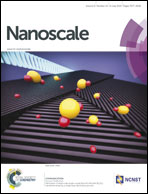Selective functionalization and loading of biomolecules in crystalline silicon nanotube field-effect-transistors†
Abstract
Crystalline silicon nanotubes (Si NTs) provide distinctive advantages as electrical and biochemical analysis scaffolds through their unique morphology and electrical tunability compared to solid nanowires or amorphous/non-conductive nanotubes. Such potential is investigated in this report. Gate-dependent four-probe current–voltage analysis reveals electrical properties such as resistivity to differ by nearly 3 orders of magnitude between crystalline and amorphous Si NTs. Analysis of transistor transfer characteristics yields a field effect mobility of 40.0 cm2 V−1 s−1 in crystalline Si NTs. The hollow morphology also allows selective inner/outer surface functionalization and loading capability either as a carrier for molecular targets or as a nanofluidic channel for biomolecular assays. We present for the first time a demonstration of internalization of fluorescent dyes (rhodamine) and biomolecules (BSA) in Si NTs as long as 22 μm in length.


 Please wait while we load your content...
Please wait while we load your content...